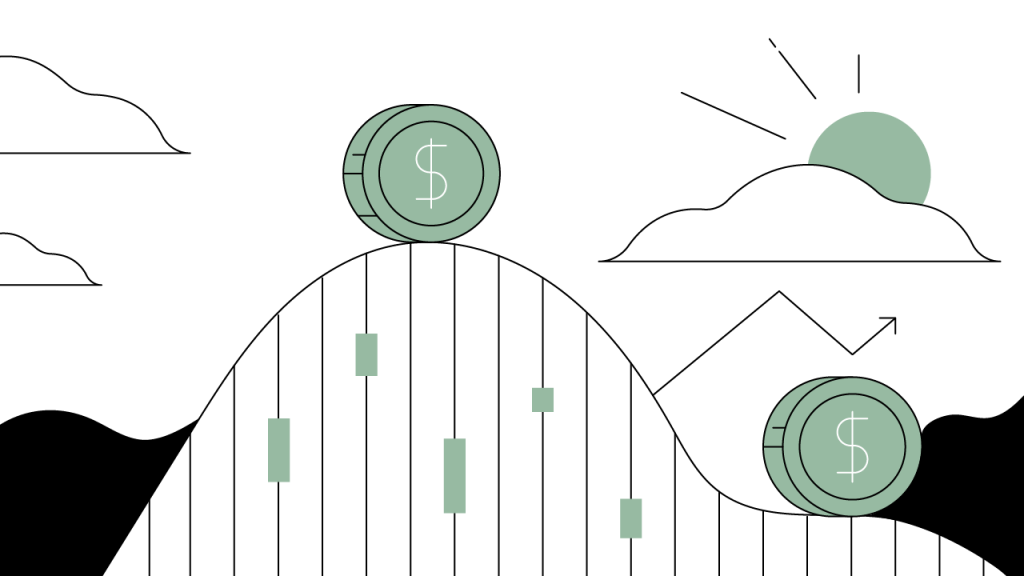Dollar-Cost Averaging: Building Wealth Over Time
Dollar-cost averaging (DCA) is a strategy where an investor invests a total sum of money in small increments over time instead of all at once. The goal is to take advantage of market downturns without risking too much capital at any given time.
By
Updated June 28, 2022 • 3 min read

Summary
Dollar-cost averaging (DCA) is a strategy where an investor invests a total sum of money in small increments over time instead of all at once. The goal is to take advantage of market downturns without risking too much capital at any given time. DCA is designed to help offset any negative effect on an investment caused by short-term market volatility. If the price of an asset drops during the time you are dollar-cost averaging, then you stand to make a profit if the price moves back up. If you’re not a professional market watcher, DCA can save you the effort of trying to time the market to get the best stock prices. It’s a tool for investing slowly and consistently that aims to protect against the human tendency to want to gain all at once.
How It Works
With dollar-cost averaging, you first decide on the total amount you wish to invest, along with your chosen investment product(s) — stocks, crypto, commodities, etc. Then, instead of investing the money as a , you invest it in smaller equal installments over a specific length of time. You may place your DCA trades manually, but there are vehicles such as and some that can do it for you, too. Once set up, your purchases occur automatically, regardless of asset price or movement in the market.
Committing to dollar-cost averaging means that, at times, you’ll be investing when the market or a particular asset has dropped in value. It also means there will likely be times when you’re buying during a market — in which a huge volume of assets sells in a very short period. Some investors might be reluctant to purchase securities during (markets experiencing price declines). But, viewed from another perspective, buying when the market is down gives you the opportunity to land potentially profitable assets — perhaps different from the ones in your DCA plan — at very low prices. By buying when others might sell, dollar-cost averaging can potentially help you to reap the benefits of buying low and selling high.
Some Drawbacks of Dollar-Cost Averaging Frequency
Because many trading platforms charge a fee each time you make a transaction, you're going to incur more trading costs with a dollar-cost averaging strategy. The good news is that DCA is inherently a long-term strategy, so ideally, fees should potentially become small relative to your potential gains over two, five, or ten years and beyond.
The most notable downside of DCA is the possibility that you might miss out on a large gain you could have earned if you had invested in a lump sum when the market was down. But any big windfall profits requires timing the market correctly, and even professional investors can’t necessarily predict intraday, or even weekly, movements of a stock or the market as a whole. DCA is a potentially safer way to take advantage of big market dips.
Another downside is that you may buy after a steep rise in asset prices and face a downward correction afterwards. A DCA strategy, over time, usually includes buying assets at any stage, whether it be stable, depreciating, or appreciating. If done consistently, a DCA strategy tends to lower your risk and does better over a long time horizon.
Is a Dollar-Cost Averaging Strategy Viable for Crypto?
DCA is much like placing an order for a recurring buy on a cryptocurrency exchange. Cryptocurrencies can be quite volatile, oftentimes even more so than stocks.
You can generate a potentially greater profit from buying during dips and selling at the top. However, there’s broad consensus that DCA is a safer overall method of investing than lump sum buying and selling. It’s lower risk and lower reward, but still offers the chance of benefiting from market swings.
With the wild swings that have occurred in the crypto market during its relatively short existence and its potential for future growth, holding digital assets has been, and may continue to be, a profitable means of investing. If you want a relatively safe way of benefiting from crypto’s volatility, a dollar-cost averaging strategy is worth considering.
Cryptopedia does not guarantee the reliability of the Site content and shall not be held liable for any errors, omissions, or inaccuracies. The opinions and views expressed in any Cryptopedia article are solely those of the author(s) and do not reflect the opinions of Gemini or its management. The information provided on the Site is for informational purposes only, and it does not constitute an endorsement of any of the products and services discussed or investment, financial, or trading advice. A qualified professional should be consulted prior to making financial decisions. Please visit our to learn more.

Author
Is this article helpful?
